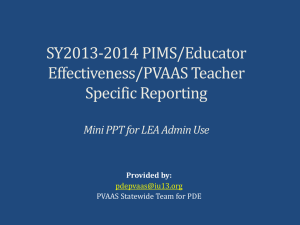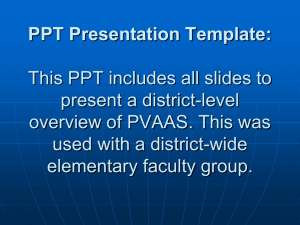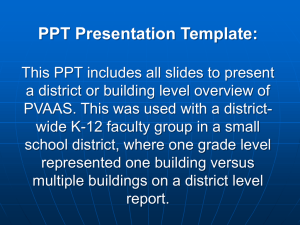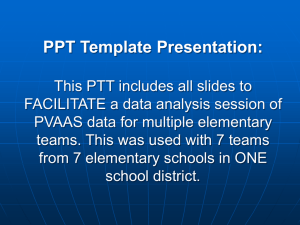PVAAS PAIU_PDE_March 9 2011
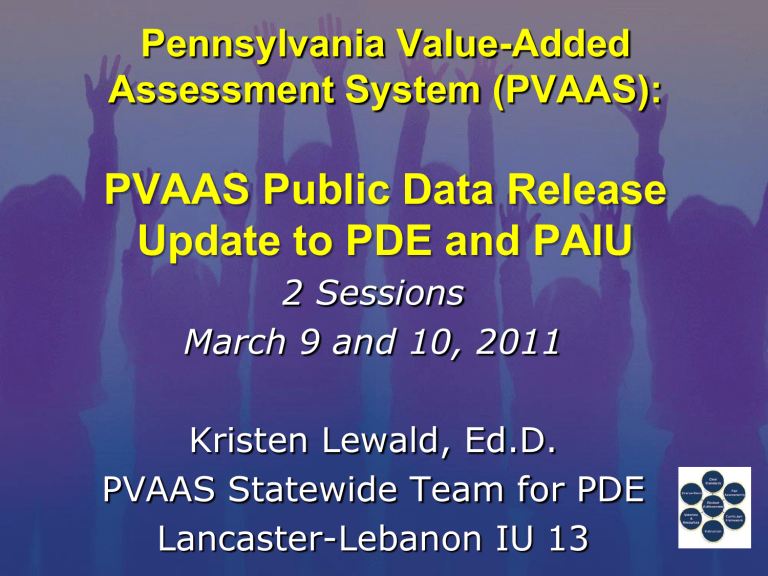
Pennsylvania Value-Added
Assessment System (PVAAS):
PVAAS Public Data Release
Update to PDE and PAIU
2 Sessions
March 9 and 10, 2011
Kristen Lewald, Ed.D.
PVAAS Statewide Team for PDE
Lancaster-Lebanon IU 13
Today’s Session
PDE and PAIU Executive Director’s
Meeting was held last Friday
Questions from public and districts/schools
Provide an update to PAIU
• PDE joining us today as well
Agenda
Achievement and Progress
Available Data & Crosswalk
Public Website Demonstration
Myths and Concerns: Feedback
Suggested Resources/Supports for
Communicating PVAAS
Questions
Achievement vs. Progress
Achievement
The final result of an academic experience
Highly correlated with demographic factors, such as socioeconomic status
Progress
Is the concept underlying valueadded analysis and reporting
Not correlated with demographic factors
Affected by factors outside the school
Dependent upon what happens as a result of schooling
ValueAdded is…
A statistical analysis used to measure a district’s or school’s impact on the academic progress rates of groups of students from year to year.
Conceptually, a growth measure is approximately the difference between current achievement (current results) and prior achievement (prior results) with achievement being measured by an appropriate assessment, such as the PSSA.
However, PVAAS is NOT a simple comparison of two scores!
PVAAS Provides:
Public Site
Looking Back/Evaluation…
Value-added Growth Reports For
Cohorts of Students
Looking
Forward/Planning…
PVAAS Projection Reports
For Individual Students and Cohorts of Students
Today
Key Concepts in Understanding
PVAAS Reporting
One of the inherent benefits of the PVAAS analyses is that all scores for all students are included in the analyses. Simplistic approaches are less precise and sometimes biased.
While PVAAS does use individual student data to yield value-added reporting, there are NO individual student measures of growth yielded from PVAAS
Value-Added & PVAAS
Pennsylvania’s model for value-added is called
PVAAS - the Pennsylvania Value-Added
Assessment System.
PVAAS is based on the EVAAS Methodology – the Education Value-Added Assessment
System.
The EVAAS methodology has been nationally reviewed and published.
PVAAS System
Uses EVAAS statistical methodology
• EVAAS: Education Value-Added
Assessment System
• Mixed Model Multivariate Longitudinal
Analyses
• Lead Developer: Dr. Bill Sanders, Univ. of
TN
Now: SAS, Inc.(Cary, NC) for
EVAAS/PVAAS
• Jim Goodnight, CEO
8 Year History of PVAAS
Pilot from 2002-2005: 100 Districts
Fall 2006: Reporting Grades 4 and 6 Reporting to all 501 Districts
Fall 2007: Grades 4-8 Reporting to all Districts
Fall 2008: Grades 4-8, & 11 Reporting to all
Districts
Fall 2009 and 2010: Full Reporting to 500 Districts
• Math, Reading, Science, Writing
• Grades 4-8, & 11
• Used as provision to meet AYP for NLCB – AYP Growth
Model
February 2011: Release of Public Reporting
Site https://pvaas.sas.com
PVAAS Data Provides
Information to:
Raise Achievement
Close Achievement Gaps
Decrease Dropouts
Increase College Readiness
Key Concepts in Understanding
PVAAS Reporting
PVAAS reporting reflects the effectiveness of your district’s or school’s
Standards-Aligned System
PVAAS reporting reflects the district’s or school’s system regarding curriculum, assessment, and instruction
PVAAS Password-Protected vs. Public Site
PVAAS yields data on Districts, Schools,
Grades, Subgroups, Students
•
Math, Reading, Science, Writing
•
Public
•
Protected
Achievement + Growth
Achievement results (PSSA) and growth results (PVAAS) must be used together to get a complete picture of student learning.
To view the achievement results of Pennsylvania's public districts/schools, go to: http://paayp.emetric.net/
Example: Achievement + Growth
Achievement vs. Growth - 4th Grade Math
56
0
PVAAS Growth Value
Example: Achievement + Growth
Same Schools
Achievement vs. Growth - 4th Grade Reading
63
0
PVAAS Growth Value
Overview of PVAAS
Public Reports &
Features:
Screen Shots, THEN
LIVE Web Demo
New PVAAS Login Page
https://pvaas.sas.com
PVAAS Public Reports
Use of Reports Tab to Select & View Reports
PVAAS Public Reports
Value-Added Summary Reports
• District/LEA and School Level data only
• Math and Reading
• Grades 4-8 and 9-11
School Search Capability
• Allows users to find and view the progress of local schools, charter schools, and full-time
CTCs across Pennsylvania.
• Can search for similar schools based on grade levels tested, various demographics,
Intermediate Unit (IU) region and/or county..
PVAAS Public Reports
• Use of Tests Tab to View
Reports at Different
Grade Levels
• Use of Subjects Tab to
View Reports for
Different Subjects
Reports on Public Site
They have a different format from the district password protected site
However, the measures on the
PVAAS public site come directly from the reports on the district/school password protected site.
We will cross walk between these two sites in this session.
3 Key Resources for Public
Reporting
Guide to Public Reporting
Crosswalk
Two pager on public reporting
Purpose of District & School
Value-Added Data
•
Provides users with information to assist them in evaluating the overall effectiveness of a district/LEA or school on the academic progress of groups of students.
• This report is NOT a report on teacher effectiveness!
Example of District Value-Added
Summary Report
Grades 4-8, Math & Reading
Example of School Value-Added
Summary Report
Grades 4-8, Math & Reading
Crosswalk: Where can I find this information on other reports?
Public Site: School Value-Added Summary Report
Restricted Site: School Value-Added Report
What is the Average Gain over Grades
Relative to the Growth Standard?
• Represents the average gain across the grade levels served between 4 and 8 compared to the Growth
Standard.
• It is the average academic growth of the district’s or school’s students, compared to the Growth Standard.
• Answers the question, “ How effective was the district/LEA/school in impacting the academic progress of its students compared to the Growth Standard?”
Example: Average Gain over Grades
Relative to the Growth Standard
Average Gain over Grades Relative to the Growth Standard (on the public report) is the SAME as the Mean NCE Gain over Grades Relative to the Growth
Standard on the School Value-Added Report (password-protected site)!
0.2
4 th Grade Gain
2.1
5 th Grade Gain
2 1.7
Average Gain over Grades
Relative to Growth Standard
What is the Average Gain over
Grades Relative to the State?
• Represents the average gain across the grade levels served between 4 and 8 compared to the average progress of all students in Pennsylvania at the same grade levels.
• It is the average academic growth of the district’s or school’s students, compared to the academic growth of students statewide.
• Answers the question, “ How much did the district/LEA/school impact the academic progress of its students compared to the progress of other students in
Pennsylvania in those same grade levels?”
Example: Average Gain over Grades
Relative to the State
Average Gain over Grades Relative to the State (on the public report) is the
SAME as the Mean NCE Gain over Grades Relative to the State on the School
Value-Added Report (password-protected site)!
1.7
Average Gain over Grades
Relative to Growth Standard for the school
?
Average Gain over Grades
Relative to Growth
Standard for the State
0.4
Average Gain over Grades
Relative to the State
What is Average Gain over Grades Relative to the Growth Standard for the State?
3.0
Grade 4 State
3-Yr-Avg
-0.4
Grade 5 State
3-Yr-Avg
2 1.3
Average Gain over Grades Relative to Growth Standard for the State
Example: Average Gain over Grades
Relative to the State
Average Gain over Grades Relative to the State (on the public report) is the
SAME as the Mean NCE Gain over Grades Relative to the State on the School
Value-Added Report (password-protected site)!
1.7
Average Gain over Grades
Relative to Growth Standard for the school
1.3
Average Gain over Grades
Relative to Growth
Standard for the State
0.4
Average Gain over Grades
Relative to the State
PVAAS Value-added
Growth Descriptors
Grades 4 – 8, Math and Reading
The Average Gain over Grades for grades 4-8 is expressed in Normal Curve
Equivalent (NCE) units. The use of the NCEs allows PSSA scores in any school year and grade level to be compared across years.
Green (Favorable) – The district/LEA/school was effective in supporting students to achieve one year’s worth of academic growth in a year.
Yellow (Caution) – There was minimal evidence that the district/LEA/school was not effective in support students to achieve one year’s worth of academic growth in a year.
Rose (Concern) – There was moderate evidence that the district/LEA/school was not effective in support students to achieve one year’s worth of academic growth in a year.
Red (Strong Concern) – There was significant evidence that the district/LEA/school was not effective in support students to achieve one year’s worth of academic growth in a year.
Example of District Value-Added
Summary Report
Grades 9-11, Math & Reading
Example of School Value-Added
Summary Report
Grades 9-11, Math & Reading
Crosswalk: Where can I find this information on other reports?
Public Site: School Value-Added Summary Report
Restricted Site: School Value-Added Report
PVAAS Value-added
Growth Descriptors
Grades 9-11, Math and Reading
The District/School Effect for grades 9-11 is expressed in PSSA scaled score points.
Green (ABOVE Predicted Achievement) – The district/LEA/school was highly effective. The district/LEA/school exceeded the expected progress with its students.
Yellow (MET Predicted Achievement) – The district/LEA/school was effective. The district/LEA/school met the expected progress with its students.
Rose (BELOW Predicted Achievement) – The district/LEA/school was not effective. The district/LEA/school did not meet the expected progress with its students.
What is the District/School Effect?
• Provides an estimate of the district’s or school’s impact on students’ academic progress. Specifically, the District/School Effect is a function of the difference between the observed/actual PSSA achievement and the predicted PSSA achievement.
•It is a measure of growth that the students tested in grade 11 have made over the past 3 years since being tested in grade 8 and uses data from grades 3-8.
• If students score as expected (i.e., students’ observed scores are equal to their predicted scores), then the District/School Effect would be 0. A negative District/School Effect indicates students’ actual scores were lower than their predicted scores, while a positive
District/School Effect indicates students’ actual scores were higher than their predicted scores.
• Answers the question, “ How effective was the district/LEA/school in promoting student academic growth and supporting students to meet or exceed their expected progress?”
Is it appropriate to compare the amount of progress made by a district/school to another district/school?
•
No! Not using the District and School Value-Added
Summary Reports o
Without taking the Standard Error into account, it is NOT possible to directly compare these gain values across districts/schools.
• The color-coding of the growth measures (gain values) does in fact take into account the Standard Error. o
Note the link to the color code legends on each report.
• The Average Growth Index found on the School Search report feature takes the Standard Error into account and allows a more direct comparison across schools.
PVAAS Public Reports
Use of Reports Tab to Select & View Reports
Purpose of School Search
•
Users can find and view the progress of public schools across
Pennsylvania and search for similar schools based on grade levels tested, various demographics,
Intermediate Unit (IU) region, and/or county.
School Search
School Search
Where can I find this information on other reports?
Public Site: School Search
Restricted Site: School Search
Which schools are included when I use School Search?
Schools with at least one tested grade in common as the “reference school” you selected AND any demographics selected, as well as IU or county region.
Example: Your reference school is a grade 6-8 school
• Other schools included in the search may include grade 6-7 schools, grade 7-8 schools,
K-6 schools, etc.
How are schools compared?
PVAAS: Average Growth Index
What is an Index?
• A numerical scale used to compare variables with one another or with some reference number
Analogy: Consumer Price Index
• A measure of the average change over a period of time
• Statistical Indicator
• Reflects patterns
The PVAAS Average Growth Index allows viewers to compare growth across schools.
What is the Average Growth Index?
• A measure of student progress across the tested grade levels in a school.
• This index is a value based on the average growth across grade levels and its relationship to the standard error so that comparison among schools is meaningful. If the standard error is not accounted for, users might get a skewed picture of the relative effectiveness of different schools.
• For grades 4 through 8, the Average Growth Index is calculated by dividing the Average Gain over Grades Relative to the Growth Standard by the corresponding Standard Error.
•For grades 9 through 11, the Average Growth Index is calculated by dividing the School Effect by the corresponding
Standard Error.
Example: Average Growth Index,
Grades 4-8
Average Growth Index
= Average Gain over Grades Relative to the Growth Standard divided by the
Standard Error
Example: Average Growth Index,
Grades 4-8
Average Growth Index
= Average Gain over Grades Relative to the Growth Standard divided by the
Standard Error
= 2.9 / 0.4
= 7.3 (due to rounding this may NOT be exactly what is reported on public site)
Example: Average Growth Index,
Grades 9-11
Average Growth Index
= School Effect divided by the Standard Error
Example: Average Growth Index,
Grades 9-11
Average Growth Index
= School Effect divided by the Standard Error
= -13.7 / 9.1
= -1.5 (due to rounding this may NOT be exactly what is reported on public site)
What is the Average Growth Index?
•
Average Growth Index > 0 On average, students in the school achieved a year’s worth of academic growth in a year. A large, positive Average Growth Index provides more evidence that more than a year’s worth of growth was experienced by the average student in the school.
•
Average Growth Index < 0 On average, students in the school achieved less than a year’s worth of academic growth in a year. A large, negative Average Growth Index provides more evidence that less than a year’s worth of growth was experienced by the average student in the school.
Why I cannot find a district/school on the PVAAS public site?
Districts/schools with less than 10 students have been suppressed
PA public reporting requirements
Districts/schools that do not receive
PVAAS reporting are not included
Example: K-3 school
PVAAS reporting is provided for reading and mathematics in grades 4-8 and 11
Why I cannot find a district/school on the PVAAS public site?
Districts/schools that only receive growth reports reflecting the progress of ONE grade level are suppressed:
Example: Grade 11 only school
Example: Grade 11-12 schools
Example: Grade 6 only school
Example: K-4 school
Act 104 legislative intent was district and building level data
Website https://pvaas.sas.com
The Myths of PVAAS
Myth #1: PVAAS provides growth measures for an individual student.
PVAAS does not estimate growth for one student because:
• The PSSA observed scores (and resulting NCE scores) are simply ‘snapshots in time’ making comparisons of the observed scores as a measure of growth very unreliable.
• The error in an estimate for a data set with only one record (one student) is too large to make the estimate meaningful…and
• Error depends on variation in data AND the sample size
(the number of student records in a dataset).
An estimate of progress, or growth, based on only one student would have a much larger error, and therefore be considerably less precise than when considering a group or cohort of students.
Myth #2: Growth is correlated with certain demographic variables.
There is NO relationship between demographic variables, such as socioeconomic status, and growth.
• There are high achieving schools making high growth;
• There are high achieving schools making low growth;
• There are low achieving schools making high growth;
• There are low achieving schools making low growth.
Growth reporting reflects what WE do with students in terms of academic growth in schools/districts.
-- VAAS can remove the effects of factors not under the control of the school. (McCaffrey, Lockwood, Koretz & Hamilton, 2003; Ross, Wang,
Sanders, Wright & Stringfield, 1999a; Wright, Horn & Sanders, 1997).
Myth #3: Growth (grades 4-8) is calculated based on how other schools perform.
Each year, a group’s growth is calculated by comparing its position in the current grade distribution from 2006 to its former position in the previous grade’s distribution from 2006.
Performance of other groups in a given year does
NOT affect the growth calculation of the cohort in question. Each group becomes its own control group!
Growth Analogy:
• For a child to get taller, another child does not have to get shorter!
• A child can grow taller in a given year no matter how his/her peers grow.
Myth #4: Since PSSA distributions change each year, growth (grades 4-8) is based on a moving target. (We could never get a green.)
All grade 4-8 growth calculations and interpretations are based on the base year distributions from 2006.
• The 2006 PSSA Math and Reading distributions provide
typical demonstrations of achievement of cohorts as they progress through the grade levels.
PSSA scaled scores are converted to NCE units using the parameters from the 2006 distributions so they are relative to the same standard each year.
SAS, Inc. (the vendor for PVAAS) evaluates each year’s distributions to verify that using the base year of 2006 continues to be appropriate.
Myth #5: PSSA is not designed to discriminate well at the extremes so growth cannot be calculated using the PSSA.
PSSAs are designed to have sufficient stretch to discriminate between Below Basic, Basic,
Proficient, and Advanced performance levels.
There is no ceiling on the PSSA! - PDE
• Each year, scores are scaled to allow the high end to be scaled on the distribution of the data – not on a fixed, pre-determined value.
The PSSA meets the three conditions to be used in PVAAS analyses.
• Must be aligned to curriculum standards.
• Must be reliable and valid.
• Must demonstrate sufficient stretch at the extremes.
Myth #6: PVAAS is not reliable or valid since it is only based on only one test, the
PSSA.
PVAAS uses a multivariate, longitudinal mixed effect model in its analyses. It is not a simple comparison of two test scores!
All prior assessment scores are used.
Standard error is always reported.
PVAAS is an indicator of growth, or progress, of groups of students towards mastery of the
Pennsylvania academic standards.
Myth #7: If students are already high achieving, it is harder to show growth.
In PVAAS, one year’s growth is about maintaining achievement levels (grades 4-8) or meeting expected performance (grades 9-11) based on a specific group’s prior academic performance.
For high-achieving groups, one year’s growth may be sufficient or acceptable.
For low-achieving schools, one year’s growth may not be sufficient or acceptable in order for students to meet long-term achievement goal of proficiency.
Myth #8: It is not possible to show progress with all groups of students, such as students with IEPs or gifted students.
If assessments have enough “stretch” to measure the achievement of both low- and high-achieving students, it is possible to measure all groups of students’ progress.
The PSSA meets the criteria!
The value-added methodology used is sensitive to individual students’ achievement levels.
It measures growth from the end of one year to the end of the next year, regardless of whether a student performs below, at, or above grade level/proficiency.
Myth #9: PVAAS should always indicate growth if our percent of students proficient/advanced increased since last year.
When following the same grade level from one year to the next in determining the percent proficient/advanced, these are two different groups of students (i.e., 6th graders in 2010 are not the same group of students as 6th graders in 2011). PVAAS on the other hand, is looking at the most recent group of students and evaluating their progress from the prior school year in the prior grade level (same group of students).
PVAAS is not measuring progress by students increasing or decreasing entire performance levels. PVAAS is sensitive to subtle changes in progress, even within performance levels.
Example: Some students may have moved from a non-proficient to proficient status. However, students already proficient/advanced may be
“slipping” in terms of their level of achievement compared to where they were the year prior. In other words, students may still be proficient/advanced, just not as high within those performance levels as they were in the prior year.
Myth #10: PVAAS cannot measure the progress of districts and schools with high mobility rates.
Value-added analysis includes all students, for which there are sufficient test data, including highly-mobile students.
From a statistical perspective, it is important to include highly-mobile students in the analysis because their exclusion could bias the results.
From a philosophical perspective, all students must be included in the school’s analysis to ensure that highly-mobile students receive the same level of attention as non-mobile students.
The EVAAS modeling approaches do take into account the quantity and quality of information available for each student!
Disclaimer for ANY Data Tool
NO data source should ever be considered in isolation.
ALL education decisions should be made on the basis of multiples sources of both quantitative and qualitative data.
ALL data provides indicators of phenomena.
When new data is gathered…
The intelligent user of data should ask:
Do these data provide insights that have not been available before?
Are these data consistent with data already collected?
Do these data confirm or conflict with our existing profile of students or programs?
What other data should be investigated in light of the new profile?
Suggested Resources for Communicating
PVAAS
Communication Resource
See “PVAAS Key Communication
Messages” – NEW!
• Key messages if you get a call from the press/media
• Or, if your IU wants to proactively assist districts, charter schools, full-time CTCs
District Press Release Template
Formal Press Release in development by PDE/PVAAS Statewide Core Team
PDE PVAAS Website, New Resources &
Professional Development Opportunities,
Intermediate Unit Supports
Suggested Resources
Guide to PVAAS Public Reporting
PVAAS Crosswalk
PVAAS Key Communication Messages
PVAAS Public Reporting Site Overview
PVAAS Evaluating Growth Projecting
Performance
PDE PVAAS
Webpage
• Help Menus
• PowerPoint
Presentations with Trainer
Notes
• Resource
Materials
• Video Clips
• District Case
Studies
Suggested Resources
Archived webinars and PowerPoint presentations detailing the public reporting site
Coming Soon! Podcasts
• Introduction to PVAAS
• Value-Added Reporting
• School Search
PVAAS Help Menus on
Public Reporting
Questions:
PVAAS Materials or
Statewide Implementation pdepvaas@iu13.org
717-606-1911
PVAAS Report Web Site https://pvaas.sas.com
www.pde.state.pa.us
333 Market Street
Harrisburg, PA 17126

